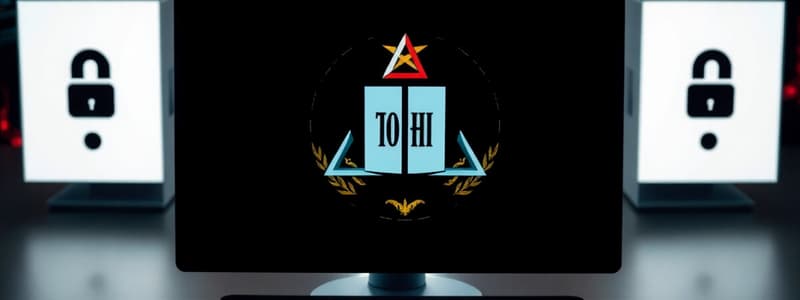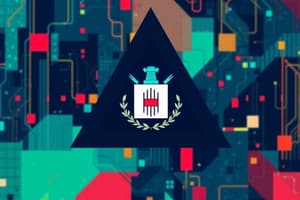Podcast
Questions and Answers
What is defined as a weakness in a system that might be exploited to cause harm?
What is defined as a weakness in a system that might be exploited to cause harm?
- Vulnerability (correct)
- Threat
- Security Policy
- Attack
Which of the following represents a potential danger that might exploit a vulnerability?
Which of the following represents a potential danger that might exploit a vulnerability?
- Risk Assessment
- Security Policy
- Vulnerability
- Attack (correct)
What type of attack involves unauthorized access to information, compromising confidentiality?
What type of attack involves unauthorized access to information, compromising confidentiality?
- Fabrication
- Modification
- Disruption
- Interception (correct)
Which attack targets the integrity of information by tampering with it?
Which attack targets the integrity of information by tampering with it?
What is meant by confidentiality in the context of information security?
What is meant by confidentiality in the context of information security?
What attack is characterized by inserting counterfeit objects into a system?
What attack is characterized by inserting counterfeit objects into a system?
Which of the following describes integrity in information security?
Which of the following describes integrity in information security?
What is the outcome of an attack focused on the availability of an asset?
What is the outcome of an attack focused on the availability of an asset?
What does availability in the CIA Triad encompass?
What does availability in the CIA Triad encompass?
Which concept ensures that a party cannot deny the authenticity of their actions?
Which concept ensures that a party cannot deny the authenticity of their actions?
Which of the following attacks would likely involve the unauthorized copying of files?
Which of the following attacks would likely involve the unauthorized copying of files?
What is a security mechanism?
What is a security mechanism?
What type of threat can arise from natural disasters or human error?
What type of threat can arise from natural disasters or human error?
Which of the following best defines a security attack?
Which of the following best defines a security attack?
Which of the following describes authorization in information security?
Which of the following describes authorization in information security?
What is meant by the term 'security services'?
What is meant by the term 'security services'?
What was a significant outcome of the Colonial Pipeline ransomware attack in 2021?
What was a significant outcome of the Colonial Pipeline ransomware attack in 2021?
What was a key security flaw in the T-Mobile data breach of 2021?
What was a key security flaw in the T-Mobile data breach of 2021?
How can better access controls help prevent vulnerabilities in supply chains?
How can better access controls help prevent vulnerabilities in supply chains?
What impact does attacking critical infrastructure have on public safety?
What impact does attacking critical infrastructure have on public safety?
What is a measure organizations should take to address vulnerabilities in widely used open-source software?
What is a measure organizations should take to address vulnerabilities in widely used open-source software?
What is the main characteristic of a passive attack?
What is the main characteristic of a passive attack?
Which of the following is an example of an active attack?
Which of the following is an example of an active attack?
What distinguishes masquerade attacks from other active attacks?
What distinguishes masquerade attacks from other active attacks?
Which of the following is a key goal of active attacks?
Which of the following is a key goal of active attacks?
What is one of the methods used in passive attacks?
What is one of the methods used in passive attacks?
Which of the following statements about active attacks is correct?
Which of the following statements about active attacks is correct?
In which attack scenario are legitimate messages altered to create an unauthorized effect?
In which attack scenario are legitimate messages altered to create an unauthorized effect?
How did the SolarWinds hack primarily occur?
How did the SolarWinds hack primarily occur?
What might be the result of an attack on the availability of an asset?
What might be the result of an attack on the availability of an asset?
How can interception be characterized in terms of security threats?
How can interception be characterized in terms of security threats?
Explain the concept of modification in the context of information security.
Explain the concept of modification in the context of information security.
What does fabrication refer to in security threats?
What does fabrication refer to in security threats?
What type of threats can result from human errors and natural disasters?
What type of threats can result from human errors and natural disasters?
What is a primary attack goal in security terms?
What is a primary attack goal in security terms?
Describe what interruption means within security threats.
Describe what interruption means within security threats.
How does security policy relate to vulnerability and threat?
How does security policy relate to vulnerability and threat?
What does the 'Availability' aspect of the CIA Triad ensure in information security?
What does the 'Availability' aspect of the CIA Triad ensure in information security?
Briefly explain what is meant by 'Integrity' in the context of information security.
Briefly explain what is meant by 'Integrity' in the context of information security.
What is the primary purpose of authentication in cybersecurity?
What is the primary purpose of authentication in cybersecurity?
Describe the concept of non-repudiation in information security.
Describe the concept of non-repudiation in information security.
How do security mechanisms contribute to information security?
How do security mechanisms contribute to information security?
What is the significance of protecting confidentiality in information security?
What is the significance of protecting confidentiality in information security?
Explain the role of authorization in a secure information system.
Explain the role of authorization in a secure information system.
What types of security services are necessary for maintaining information security?
What types of security services are necessary for maintaining information security?
What is the primary difference between passive and active attacks?
What is the primary difference between passive and active attacks?
Name two specific types of passive attacks.
Name two specific types of passive attacks.
What are the challenges associated with preventing active attacks?
What are the challenges associated with preventing active attacks?
What is a masquerade attack?
What is a masquerade attack?
How does a replay attack function?
How does a replay attack function?
Explain what a denial of service attack entails.
Explain what a denial of service attack entails.
What was the main vulnerability exploited in the SolarWinds Hack of 2020?
What was the main vulnerability exploited in the SolarWinds Hack of 2020?
What is the purpose of traffic analysis in passive attacks?
What is the purpose of traffic analysis in passive attacks?
What vulnerabilities were exploited in the Colonial Pipeline ransomware attack, and how could they have been prevented with improved security measures?
What vulnerabilities were exploited in the Colonial Pipeline ransomware attack, and how could they have been prevented with improved security measures?
In the T-Mobile data breach, what key security flaws allowed hackers to access personal information of millions?
In the T-Mobile data breach, what key security flaws allowed hackers to access personal information of millions?
How did the Log4j vulnerability demonstrate the risks associated with widely used open-source software?
How did the Log4j vulnerability demonstrate the risks associated with widely used open-source software?
What are effective strategies for preventing ransomware attacks on critical infrastructure?
What are effective strategies for preventing ransomware attacks on critical infrastructure?
How could better access controls and system monitoring have prevented vulnerabilities in the supply chain?
How could better access controls and system monitoring have prevented vulnerabilities in the supply chain?
What are the main user threats that can compromise an organization's data security?
What are the main user threats that can compromise an organization's data security?
How can device vulnerabilities affect an organization's IT infrastructure?
How can device vulnerabilities affect an organization's IT infrastructure?
What is an Advanced Persistent Threat (APT), and how does it differ from other cyber attacks?
What is an Advanced Persistent Threat (APT), and how does it differ from other cyber attacks?
What role do backdoors and rootkits play in cybercriminal activities?
What role do backdoors and rootkits play in cybercriminal activities?
What are the consequences of using devices with outdated software in a security context?
What are the consequences of using devices with outdated software in a security context?
Describe the potential threats posed by IoT devices within an organization.
Describe the potential threats posed by IoT devices within an organization.
In what ways can poor enforcement of security policies lead to security breaches?
In what ways can poor enforcement of security policies lead to security breaches?
Explain how malware can be introduced into an organization’s system through unauthorized USB drives.
Explain how malware can be introduced into an organization’s system through unauthorized USB drives.
What is the main objective of social engineering attacks?
What is the main objective of social engineering attacks?
How can organizations defend against social engineering techniques?
How can organizations defend against social engineering techniques?
What is shoulder surfing and how is it typically conducted?
What is shoulder surfing and how is it typically conducted?
What is dumpster diving and what should be done with sensitive documents?
What is dumpster diving and what should be done with sensitive documents?
What distinguishes impersonation from other forms of deception in cybercrime?
What distinguishes impersonation from other forms of deception in cybercrime?
What does the term 'quid pro quo' in social engineering refer to?
What does the term 'quid pro quo' in social engineering refer to?
Why is it important for employees to avoid disclosing information to unknown parties?
Why is it important for employees to avoid disclosing information to unknown parties?
What are the potential risks associated with hoaxes in cybersecurity?
What are the potential risks associated with hoaxes in cybersecurity?
What are the three main components of a computer virus?
What are the three main components of a computer virus?
How does a logic bomb work?
How does a logic bomb work?
What is the primary function of ransomware?
What is the primary function of ransomware?
In what way do worms differ from traditional viruses?
In what way do worms differ from traditional viruses?
Describe the payload of a virus.
Describe the payload of a virus.
What motivates cybercriminals to deploy malware like Trojan horses?
What motivates cybercriminals to deploy malware like Trojan horses?
What key security policy should employees adopt regarding unknown contacts?
What key security policy should employees adopt regarding unknown contacts?
What role does employee education play in organizational security?
What role does employee education play in organizational security?
What method do cybercriminals use in a remote code execution attack?
What method do cybercriminals use in a remote code execution attack?
What is the first step in defending against application attacks?
What is the first step in defending against application attacks?
What characterizes spam emails that might indicate they are malicious?
What characterizes spam emails that might indicate they are malicious?
How do outdated applications contribute to application attacks?
How do outdated applications contribute to application attacks?
What should an employee do upon receiving a suspicious email?
What should an employee do upon receiving a suspicious email?
What is privilege escalation in the context of application attacks?
What is privilege escalation in the context of application attacks?
What role does input validation play in application security?
What role does input validation play in application security?
Why is it important to filter spam emails?
Why is it important to filter spam emails?
What is the main risk associated with ransomware attacks after the ransom is paid?
What is the main risk associated with ransomware attacks after the ransom is paid?
What two main methods do Denial of Service attacks rely on?
What two main methods do Denial of Service attacks rely on?
How do Man-in-the-Middle attacks operate?
How do Man-in-the-Middle attacks operate?
What characterizes a Zero-Day attack?
What characterizes a Zero-Day attack?
What are some common ways ransomware spreads to victims?
What are some common ways ransomware spreads to victims?
What potential impact can a Denial of Service attack have on an organization?
What potential impact can a Denial of Service attack have on an organization?
What role does user awareness play in preventing Man-in-the-Middle attacks?
What role does user awareness play in preventing Man-in-the-Middle attacks?
Which aspect of network security is crucial for defending against Zero-Day attacks?
Which aspect of network security is crucial for defending against Zero-Day attacks?
Study Notes
Vulnerability and Threat
- Vulnerability: A weakness in a system that might be exploited to cause harm.
- Threat: A potential danger that might exploit a vulnerability.
Information Security Concepts
- Confidentiality: Keeping information secret and accessible only to authorized individuals.
- Integrity: Ensuring information is accurate and hasn't been tampered with.
- Availability: Making sure that information and systems are accessible when needed.
- Authentication: Verifying the identity of a user or device.
- Authorization: Granting specific access permissions to individuals or devices based on their role or need.
- Non-repudiation: Preventing parties from denying their involvement in a transaction or action.
Types of Attacks
- Passive Attack: Obtaining information without altering the system.
- Interception: Intercepting information being transmitted.
- Traffic Analysis: Analyzing network traffic patterns to gain information.
- Active Attack: Altering system functionality or data.
- Masquerade Attack: Impersonating a legitimate user or system.
- Modification/Alteration: Changing information without authorization.
- Fabrication: Creating fake information or events.
- Replays: Repeating legitimate transmissions, often after capturing and storing them.
- Denial of Service (DoS) Attack: Overloading a system to make it unavailable.
- Man-in-the-Middle Attack: Intervening in a communication between two legitimate parties.
- Zero-Day Attack: Exploiting vulnerabilities before a patch is available.
Security Mechanisms
- Security mechanisms: Features, processes, or tools designed to protect information and systems.
Threats to Information Security
- Accidental Threats: Caused by human errors or natural disasters.
- Deliberate Threats: Intentional actions by attackers.
Attack Goals
- Confidentiality: Stealing sensitive information.
- Integrity: Tampering with data and systems.
- Availability: Disrupting operations and making systems unavailable.
Specific Attack Scenarios
- SolarWinds Hack: A supply chain attack where attackers compromised software updates from SolarWinds, allowing them to infiltrate networks using a backdoor.
- Colonial Pipeline Ransomware Attack: Attackers exploited vulnerabilities in Colonial Pipeline's systems, encrypting data and demanding ransom to restore it.
- T-Mobile Data Breach: Hackers gained access to sensitive data through a flaw in T-Mobile's systems, resulting in a massive data breach.
Preventing Security Breaches
- Robust Access Controls: Restricting access based on roles and needs.
- Regular Software Updates: Patching vulnerabilities in software.
- Employee Training: Teaching employees about security best practices.
- Strong Security Policies: Defining rules and procedures for secure information handling.
Security Challenges
- Open-Source Software Vulnerabilities: Bugs in popular open-source software can affect a large number of systems.
- Supply Chain Vulnerabilities: Attackers can target vulnerabilities in the supply chain to compromise organizations.
- User Threats: Users can accidentally or intentionally compromise security through careless actions.
- Device Vulnerabilities: Weak security on devices can create entry points for attackers.
Advanced Threats
- Advanced Persistent Threat (APT): A sophisticated and targeted attack, often conducted by nation-states or organized criminal groups.
- Backdoors and Rootkits: Hidden tools used by attackers to gain persistent access to systems.
Malware
- Computer Virus: Code that spreads from one program to another, often causing harm.
- Logic Bomb: A program designed to cause harm at a specific time or under certain conditions.
- Ransomware: Software that encrypts data and demands ransom for its decryption.
- Worm: Self-replicating malware that spreads across networks without human interaction.
- Trojan Horse: Malware disguised as legitimate software.
Social Engineering
- Social Engineering: Manipulating people into revealing information or granting unauthorized access.
- Shoulder surfing: Looking over someone's shoulder to see what they are typing.
- Dumpster diving: Searching through trash for sensitive documents.
- Impersonation: Pretending to be someone you are not.
- Quid pro quo: Offering something in exchange for something else, often information.
Protecting Against Social Engineering
- Employee awareness: Training employees to recognize social engineering tactics.
- Strong passwords: Using unique and complex passwords.
- Avoiding phishing attempts: Being cautious about clicking on suspicious links or opening attachments.
Application Attacks
- Remote code execution: An attacker executes code on a victim's computer without their knowledge.
- Privilege escalation: Gaining higher-level access to a system.
- Input validation: Preventing attackers from manipulating input to exploit vulnerabilities.
- Spam filtering: Blocking unsolicited and potentially malicious emails.
Network Attacks
- Denial of Service (DoS): Overloading a network or system, making it unavailable to legitimate users.
- Flood attack: Sending a massive number of requests to a server.
- Slowloris attack: Sending slow, incomplete requests to a server.
- Man-in-the-Middle Attack: Intervening in a communication between two parties to intercept data.
- Zero-Day Attack: Attacking a vulnerability before a patch is available.
Protecting Networks
- Network segmentation: Dividing the network into smaller, isolated segments.
- Intrusion detection systems (IDS): Monitoring network traffic for suspicious activity.
- Firewalls: Filtering traffic based on rules to block unauthorized access.
- User awareness: Training users to recognize and avoid suspicious activity.
Studying That Suits You
Use AI to generate personalized quizzes and flashcards to suit your learning preferences.
Description
Explore the fundamental principles of computer security, including the importance of the CIA Triad: Confidentiality, Integrity, and Availability. Learn how these concepts protect information systems from unauthorized access and modifications.





